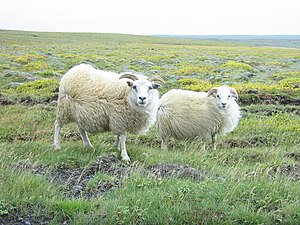Icelandic sheep
The Icelandic sheep is a breed of sheep that belongs to the Nordic short-tailed sheep . Icelandic sheep are medium-sized, usually short-legged and sturdy. The sheep's face and legs are free from wool , which can take on 17 different shades from white to brown to black. Because the sheep are usually not sheared before winter, the sheep are very cold-tolerant because of their thick fur.
A specific gene has been discovered in the breed that promotes multiple births. Twin births are the norm, but triplets, quadruplets and, in very rare cases, quintuplets or sextuplets can be born. The lambs become sexually mature at around 11–12 months.
history
Icelandic sheep are descended from a breed that was brought to Iceland by the Vikings 1100–1200 years ago . Because they have been able to adapt to the harsh climate for over a thousand years, they are considered a very robust breed of sheep and made a significant contribution to the nutrition of the local population, since sheep breeding in winter was the only way to get fresh food due to the unfavorable climatic and geographical location to get.
Today there are around 500,000 Icelandic sheep left in Iceland.
flesh
In Iceland, the undemanding sheep that only feed on grass and hay are used almost exclusively for meat. The lambs can be slaughtered when they are four to five months old and then weigh around 32–41 kilograms. The meat is very tasty and is considered a delicacy .
Wool
The wool of the sheep Iceland has two different types of fibers : the guard hairs, the Tog are called, and the undercoat named Thel (Thel). The tog is made of medium-thick hair (~ 27 microns in diameter) and is used to weave durable clothing ; the finer fibers of thel are only about 20 micrometers thick and are used for clothing that is to be worn next to the skin.
Tog and Thel are used together to make Lopi , a very lightly twisted yarn made only from the wool of Icelandic sheep.
milk
In the past, Icelandic sheep were also used to produce milk. After the birth of the lambs , the ewes give milk for 8 weeks, with the lambs being weaned after two weeks and the sheep being milked for the next six weeks. Most sheep provide around 1 liter of milk a day, but amounts up to 3 liters are not uncommon. After milking, the milk was either drunk or made into butter , skyr, or yogurt . The milk of the sheep is well suited for cheese making because of its high fat content.
Today the sheep are usually no longer milked.

